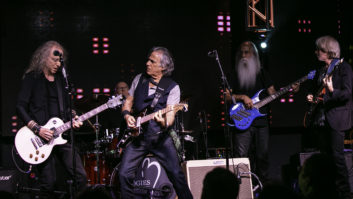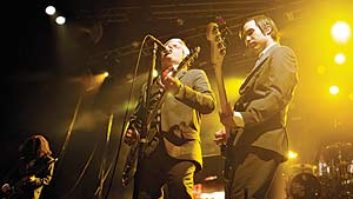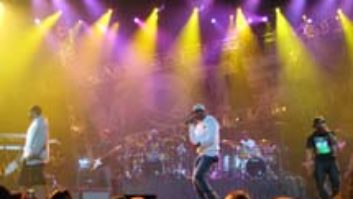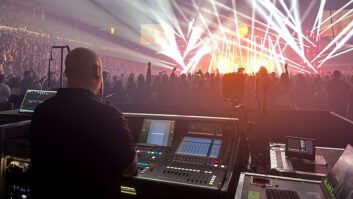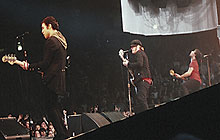
Hard to believe, but it’s been more than 40 years since The Who released the seminal rock anthem “The Kids Are Alright.” Catching up with young rockers Fall Out Boy recently in the midst of their first arena tour, it seems that Pete Townshend’s lyrical sentiments are holding up just fine.
“These are guys you hang out with at the mall. They’re just super-nice kids, with the only difference being that they have the souls of old metal and hardcore players,” notes Kyle Chirnside, front-of-house engineer who’s been onboard the Fall Out Boy train since they began club touring just a couple of years ago. The four-member punk-rock-tinged-with-pop band bring catchy (and often darkly humorous) wordplay, driving melodies and a whole lot of youthful frenzy to the stage. Their original compositions are the result of a collaborative process that sees the lyrics of bass player Pete Wentz married to a “musical engine” created by lead singer Patrick Stump and enhanced by the contributions of lead guitarist Joe Trohman and drummer Andy Hurley.
In late April, Mix checked in at the current tour’s stop at The UIC Pavilion on the campus of University of Illinois-Chicago, the band’s hometown.
SPEC’ING THE P.A.
This marks Chirnside’s fifth tour with the band, and though he’s been mixing and doing system tech work since his mid-teens in St. Louis, it’s his first experience with a full-fledged arena tour. He takes it in stride, joined by monitor engineer Mike Baehler and system engineer/crew chief Dave Coyle, a veteran working with Clair/Showco, the sound company that is supporting the tour and the Showco PRISM house system.
“I felt very strongly about this P.A. for the specific sonic and coverage needs of this tour,” Chirnside explains. His first exposure to PRISM involved mixing a radio show in Texas a few years ago for Audioslave, where he didn’t get soundcheck before being thrown into the live mix. “The engineering of the PRISM loudspeakers is inspired — all of those great components and how they’re integrated. There was some serious time put into the design of this system. The power and coverage is tough to beat.

Lead singer Patrick Stump
photo: Keith Clark
“The wrap of the clusters is seamless; there are no holes in the coverage,” he continues. “We just scale the cluster structure to the specific coverage needs of the venue. We’re able to attain a full 270 degrees of full-spectrum output from clusters that are usually only eight boxes wide by five boxes high, and I want the folks in the ‘nose-bleed’ territory to get the same thing as the folks on the floor. Line arrays would require more side- and out-fill boxes that make for more work in terms of both rigging and integrating coverage, and they’d also interfere with sightlines on the sides.”
Coyle is filling the system tech role on this tour, but he’s equally adept at both house- and monitor-mixing duties, and will be providing the latter on the upcoming System of a Down tour. “The thing a lot of people don’t know about PRISM is that it’s a very quick P.A. in terms of getting it in and out of the building,” he notes. “I was concerned that maybe we hadn’t brought enough subwoofers [there are six PRISM subs per side], but it would be overkill to add more. We’re getting plenty of low end from what we’ve got, supplemented by the solid low presence from the mains. Besides, this band doesn’t have a lot of heavy ‘double kicks’ that would benefit from more on the low end.”
Promotional scrims (dictated by the tour sponsor) flown in front of both clusters obscure the view but haven’t detracted from audio performance. Chirnside and Coyle both shrug their shoulders in a “what are you gonna do?” manner when asked about the scrims, noting that a bit of mid-high boost in the system EQ has negated any perceptible loss.
The PRISM amplification package is Crown Macro-Tech Series, stowed in racks under the stage. Out front, dual PRISM 1041 digital system controllers are joined by Clair iO digital processors. “I don’t ever want to go back to the ‘grab the slider’ approach for system EQ,” Chirnside says. “With the iO, it’s all right there, and you can wander around with a wireless tablet and tweak from wherever you want to be in the room. And there are so many frequencies between the 31 bands of EQ that can be addressed and fixed with the iO. It’s mind-boggling how easy and cool it is to tune a rig within a room these days.”
Coyle and Chirnside start the tuning process with the amplifiers because each amp is driving a different box in the air, optimizing long, medium and down throw. Then it’s on to final EQ, with any anomalies addressed in the iO. “I’m using [SIA] Smaart Live for analysis help more on this tour than I’ve done previously because it’s a lot easier to excite an arena due to so many large, flat spaces,” Chirnside adds. “I also keep an eye on Smaart during a show, but am careful to avoid becoming a slave to it. The best tools are still your own ears.”
FRONT-OF-HOUSE EFFECTS
Chirnside says his Midas XL4 FOH console is “the best board on the planet, period,” noting its overall comfort zone and the warm signature of the mic preamps. All opening acts are on a Yamaha PM5D digital console, which is ideal due to its repeatability.
Just 22 inputs — and sometimes even fewer — are allocated to Fall Out Boy. If an arena proves especially boomy, Chirnside will cut a couple of inputs to tighten things up. “You won’t see anything different on my desk than you would at a club show.” The biggest mix challenge is presented by the band’s frenetic action throughout a show. They sprint, jump and mount stage wings and anything else that can be climbed, banging their instruments on the drums.
“The theme is ‘polish it up,’” Chirnside says. “Jumping around with a guitar, bending the head stock and whatever is going to present tuning issues. So the goal is staying on top of tuning and intonation.”

Front-of-house engineer Kyle Chirnside at his XL4 prior to the show in Chicago.
photo: : Keith Clark
One trick he’s employing, first picked up on the Warped tour, is to apply the voice doubler of a Yamaha SPX-990 on guitar to help smooth out intonation during peak crazy times. Gates and compression are fairly minimal, with channels of dbx 160A applied to bass and drums.
An Empirical Labs EL8 Distressor compressor is used on Stump’s vocal, via an Audix OM7 microphone, to keep it on top of the mix without having to constantly ride his fader, with an Eventide H3000 also used for just a touch of reverb depth. “Patrick’s a really solid singer, so you don’t have to do a lot with his voice, but the Distressor has a highpass filter that cuts down the boom and keeps things steady,” Chirnside explains. Distressors are also used on backing vocals (also on wired Audix OM7 mics), snapping that portion in line with the lead.
Levels in the house tend to run at a consistent 105 to 107 dB at FOH, and within that framework, Chirnside focuses on presenting a compelling mix. “With this particular punk rock style, it’s pretty much one level at all times — full force for three minutes and the song is done,” he says. “As an engineer, you have to try to tastefully add dynamics as you go; for example, push up a guitar or quickly pan it to one side for a single-note solo, which brings up the subject of solos in general, and this band doesn’t really do them. Rather, it’s more melody riffs over harmony guitars and the like. You feel it out, move the mix around and make it different so it doesn’t get stagnant.”
WELCOME TO STAGE RIGHT
Monitor engineer Mike Baehler enjoyed his first “real gig” mixing monitors for Wayne Newton more than a decade ago. Since then, he has worked with bands such as Hot Hot Heat and Less Than Jake. He says his focus with Fall Out Boy, when he mans the Yamaha PM5D (running 17 mixes), is “trying to help the band have a good time so the audience has a great time. That’s the biggest priority. None of us are big into rules.”
Stump recently switched to in-ear monitoring, retaining his stage wedges as props only. This further helps clean up his vocal feed. However, Stump doesn’t like to hear his vocals in his monitor mix, just guitar and kick/snare drum. “Patrick’s got this ‘muscle memory’ ability with his vocal, and it’s kind of amazing. We get some strange looks when we do one-offs and request no vocal presence in the center mix,” Chirnside notes with a laugh.
Given Stump’s transition to in-ear monitors and that drummer Hurley has used them from the outset (both have custom-molded Ultimate Ears earpieces on Sennheiser wireless systems), the two musicians have become more tightly locked into each other, which has tightened up the overall sound. The other two players remain on dual wedges. Sidefills help fill in the gaps when the band runs around the stage, with one side stack providing bass and the other side guitar only.

The Clair iO tablet and SIA Smaart at the ready at front of house.
photo: Keith Clark
The mic complement is relatively straightforward. Each guitar cabinet is miked with a Sennheiser MD 409 and Shure SM57 tandem. Hurley’s drums feature an Audix D6 and Shure SM91 on kick, Audix D1 on snare top and SM57 on snare bottom, and Audio-Technica AE3000 condensers on each tom. “We had dynamic mics on the toms but the sound was a bit ‘clacky,’” Chirnside explains. “Some of the newer metal and pop bands also seem to have this problem: getting too much of the attack rather than the sound of the drum. The switch to the AE3000 has cleared it up for us.”
On the cymbals, he’s gone with Audix Micro-D condensers mounted beneath as opposed to above. It’s a move to negate the practices of both Trohman and Wentz, who tend to bang their instruments on the cymbals.
As Fall Out Boy continue their world tour, Chirnside reflects on his own path from doing club sound for bands in vans to this current arena tour. “I remember standing outside the American Theater in St. Louis when I was a kid, thinking I wanted to be on a tour like that someday,” he remembers. “It took some time and a lot of work, but it’s nice finally being here. And it’s especially nice being able to work with these young, talented musicians who remain really good people despite all that’s going on.”
Keith Clark is a freelance writer/editor specializing in professional audio.
